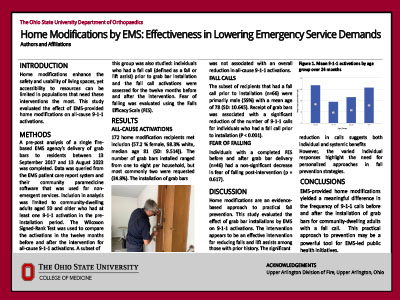ABSTRACTS
Home Modifications by EMS: Effectiveness in Lowering Emergency Service DemandAuthor: Elizabeth Sheridan Wagg, Jessica Wiseman, Catherine Quatman-Yates, and Carmen Quatman | | Associate Authors:
Introduction: Home modifications enhance the safety and usability of living spaces, yet accessibility to resources can be limited in populations that need these interventions the most. Objective: To evaluate the effectiveness of EMS-provided home modifications on all-cause 9-1-1 activations. Methods: A pre–post analysis of a single fire-based EMS agency’s delivery of grab bars to residents between September 13, 2017, and August 13, 2023, was completed. Data were queried from the EMS patient care report system and community paramedicine software that was used for nonemergent services. Inclusion in analysis was limited to community-dwelling adults aged 50 years and older who had at least one 9-1-1 activation in the preinstallation period. A Wilcoxon signed-rank test was used to compare activations in 12 months before and after the intervention. Results: A total of 172 home modification recipients met inclusion (54.7 % female, 98.3% White, median age 82 years [SD = 9.545]). The number of grab bars installed ranged from one to eight per household, but most commonly two were requested (34.9%). The installation of grab bars was associated with a significant reduction of the number of 9-1-1 calls (p < .001). Conclusion: EMS-provided home modifications yielded a meaningful difference in the frequency of 9-1-1 calls before and after the installation of grab bars for community-dwelling adults. This practical approach to prevention may be a powerful tool for EMS-led public health initiatives.
|

